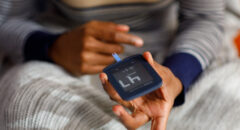
Roughly one in three preteens and teens ages 12 to 17 in the United States had prediabetes in 2023, according to new data released by the Centers for Disease Control and Prevention.
The CDC estimates that 8.4 million adolescents — or 32.7 percent of the U.S. population in that age group — showed signs of prediabetes last year. The condition, marked by elevated blood sugar levels that aren’t high enough to qualify as Type 2 diabetes, increases the risk of developing diabetes, heart disease, and stroke.
The agency called prediabetes a “critical warning sign” and urged early intervention to prevent long-term complications. In a statement to ABC News, Dr. Christopher Holliday, director of the CDC’s Division of Diabetes Translation, said Type 2 diabetes poses “a significant threat” to the health of young people.
“Simple life changes – like healthy eating and staying active – can make a big difference in preventing or delaying Type 2 diabetes,” Holliday said. He called the new data “a wake-up call.”
The CDC says risk factors for prediabetes include being overweight, low levels of physical activity, and having a family history of Type 2 diabetes. The condition can often be reversed with early lifestyle changes, including increased exercise and healthier eating habits.
The rise in prediabetes among youth coincides with a separate trend in adult diabetes cases. After more than 10 years of decline, the number of new diabetes diagnoses among adults has stopped decreasing, with about 1.5 million new cases reported in 2023, according to the CDC.
RELATED: 3 Things You Can Do to Prevent Prediabetes Today
To help reduce the risk of Type 2 diabetes in adults, new medications are showing promising results. Eli Lilly’s experimental drug tirzepatide, also known by the brand name Zepbound, is one example.
In a separate report from BDO, the drug was shown to reduce the risk of developing Type 2 diabetes by 94 percent in adults with prediabetes during a large clinical trial.
As previously reported by BDO, tirzepatide was tested on 1,032 adults who were either overweight or obese and had prediabetes. The treatment period lasted 176 weeks, followed by a 17-week off-treatment phase. The results, published in the New England Journal of Medicine, showed that adults who received the 15 mg dose experienced an average 22.9 percent drop in body weight, compared to just 2.1 percent in those given a placebo.
Tirzepatide works by activating two hormone receptors, GIP and GLP-1, which help regulate appetite and blood sugar. It improves insulin sensitivity and supports glucose control, according to Eli Lilly.

The drug could offer added benefit for communities at higher risk. The CDC reports that 13.2 percent of Black Americans have been diagnosed with Type 2 diabetes, a rate higher than most other racial and ethnic groups.
Genetic, social, and economic factors all contribute to higher obesity and diabetes rates among Black Americans, making drugs like tirzepatide a potentially important part of a broader health strategy.
“Obesity is a chronic disease that puts nearly 900 million adults worldwide at an increased risk of other complications such as Type 2 diabetes,” said Dr. Jeff Emmick, senior vice president of product development at Eli Lilly.
Eli Lilly plans to seek further approval from the U.S. Food and Drug Administration to expand the use of tirzepatide beyond its current indications. So far, the drug’s focus remains on adult patients.
But as the CDC’s data shows, younger people may also be on a concerning path toward chronic illness. Public health experts say better education, access to healthy food, and physical activity programs are key to slowing the trend.
The CDC continues to encourage families and schools to pay close attention to adolescent health habits, particularly as many teens with prediabetes may not yet know they have it.









